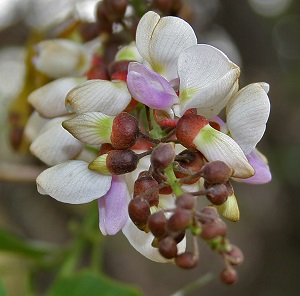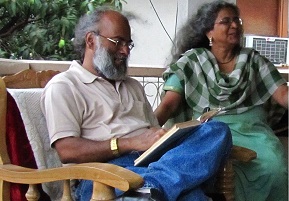
Anagha, my daughter, told me yesterday her oldest memory is of me giving her lunch. She remembers me giving her small pieces of lady’s finger sabzi,1 making up stories about it. She remembers me telling her stories about two guys called Bhindi2 Martand and Chand Martand. She was standing on the window sill of our first floor house in Lake Town,3 looking out, jumping up and down holding on to the grill of the window and trying to avoid the vegetable, and I coaxed her to eat each piece by adding new twists to the story of these two strange guys who did whatever our fantasy dictated.

That made me wonder what my own first memory was. It was of one evening in my mother’s village when I was about two years old. It was a beautiful village whose name meant Jasmine Land, among the Western Ghats, some of the oldest mountains in the world. A not very wide winding road passed by our house. Today it is a six lane national highway and the place where our house stood – where I was born – has gone under the highway as the road was widened twice. It is a very busy road today, with a thousand vehicles plying every day and not the sleepy one it used to be with a bus making four trips a day, of which everyone knew the timings, and which in fact functioned as our clock. Our house was close to the 6th stone – each stone marking a mile’s distance from the big town close by.

That evening we were sitting on the flat white rock in our courtyard. The rock was under a large pinnatta tree known as the Indian beech tree or ungu, the leaves of which are used for keeping things cool – the tree had beautiful pink and white flowers, bunches and bunches of them, with a heady fragrance of their own, and it had the reputation of being the coolest tree in the world. As we sat on the flat rock, with every passing waft of breeze showers of flowers fell on us, transforming the evening into pure magic. The wafts also brought us the scent of myrtle that was used as hedges all around our compound. I loved the shoe-flowers among the myrtle, red with white spots all over, with their beautiful, long stamens that looked like bunches of bananas and danced in the air joyously when the breeze tickled them.

After sitting on the rock for a while we got up and crossed the road to go to the shrine of the Goddess – Amman Kovil – on the other side. It was a tiny one room shrine with a small veranda in front of it. There were four of us – one of my cousins, an aunt and my sister, apart from me. My sister was about four and both my cousin and the aunt were ‘big girls’ – they were both six. They asked me to light the evening lamp in the Amman shrine, which I did. I lit the lamp in front of Amman and the two lamps on the wall outside. It was our family’s privilege to light the lamp in the shrine every evening and I probably had the honour of lighting the lamp because it had to be done by a boy – I am not sure. After lighting the lamps, we prayed and then crossed back to this side of the road to come back and sit on the white rock.
There, my cousin Sarasu, who was the leader of the group, told us a story about an old, old woman perched atop the giant tamarind tree a little away. When someone approached the tree the woman would lower an appam – pua –4 tied to the end of a single strand of her long grey hair. If you caught hold of the appam, you are finished – you can’t let go of it and she would pull you up to the top of the tree with that strand of hair and there eat you up and only your bones, nail, teeth and hair would be left.
The beautiful pinnatta flowers were still intermittently falling on us, the breeze was soft on us, we could see from where we sat the Amman Kovil lamps; there was a dim lamp lit in the herbal medicine shop of Mooppan close to the kovil from which the breeze carried to scents of numerous dry herbs that intoxicated us. The daylight was still lingering, but in spite of that we shivered in dread as she told us of the old woman on the tamarind tree.

It was cousin Sarasu who decided the next step – we should all take a walk before it was too dark. My sister and I were scared since we had to cross the tamarind tree. But Sarasu told us not to be afraid – all we had to do was avoid looking at the tamarind tree as we passed it. The old woman never made a sound – she called you to her by her eyes. So if you don’t look at her then there was nothing to be afraid of. Just walk by as though the old tamarind tree did not exist.
However, we were trembling as we neared the tree. Sarasu took me behind her and Aunt Amba took my sister behind her and that is how we crossed the tree. I did look back at the tree after we crossed it – just one quick look but probably the old woman was hidden by the tamarind leaves. She did it when she did not want to be seen.
The only other things I remember from the long walk were the sprawling ancient trees that lined both sides of the road. Some of them had fruits of slightly sweet but otherwise indifferent tastes, and there was a single young mayflower tree in bloom among the ancient trees – I was too young to think it looked like a beautiful young woman in the prime of her youth surrounded by doddering old men.

The walk back was uneventful. But the whole evening is bathed in magic for me even after all the decades that have since passed.
Maybe it will be the same for my daughter whenever she recalls that lunch time with me in the company of Bhind Martand and Chand Martand in Lake Town.
Prof. Satya Chaitanya is an educator and corporate trainer with over 30 years of experience and has given training sessions to IAS, IPS, IFS and IRS officers, scientists, corporate executives, businessmen, doctors, engineers, college professors, school teachers, and entrepreneurs.
More than three hundred of his articles and papers are available online, on such subjects as spirituality, epics, mythology, Bhagavad Gita, Zen, women, leadership, management, education and so on.
Prof. Chaitanya lives in Jamshedpur in the eastern province of Jharkand, India.
